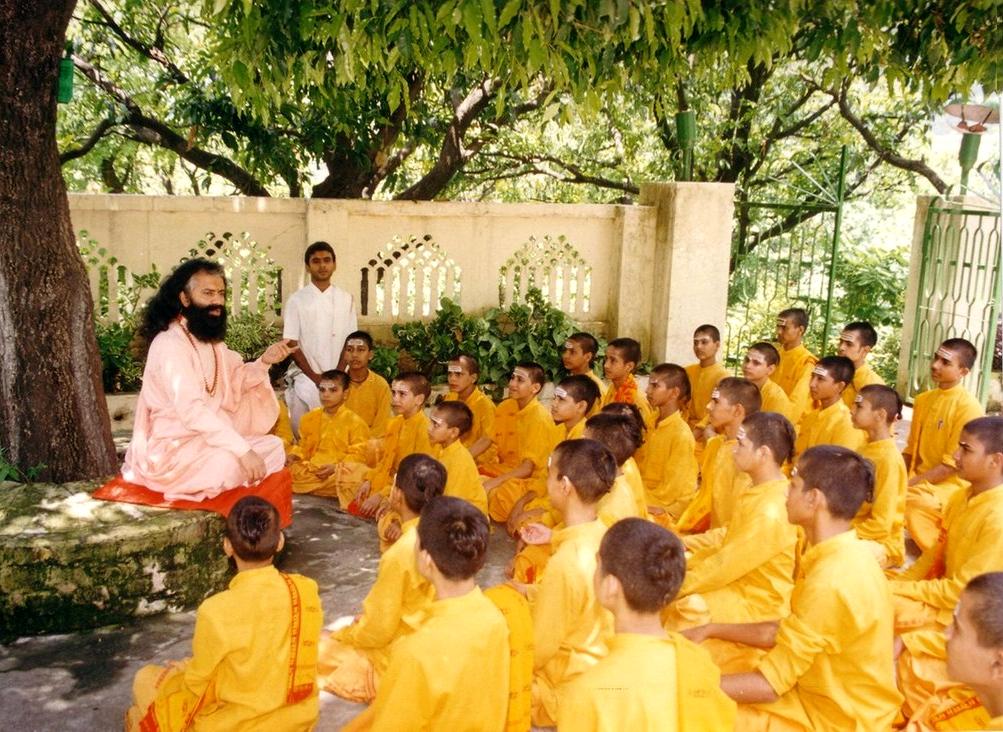
Indian Modern Religious Schools: Hindu Schools

Figure 1.--This is a Guru teaching students in a modern gurukula. It is the gurukul at the Parmarth Niketan Ashram. Notice safron colored robes. This is why saffron is seen as the color of religion in India. A major debate in Indian education today is over the red (Marxist) and safron (religious) views introduced into the currivculum.
|
|
A gurukula or gurukulam ( गुरुकुल ) was a type of residential school in ancient India. Here the shishya (students / disciples) lived near or with the guru in the same house. This was not uniqely Hindu. The guru-shishya system was a sacred tradition. It was followed by religious faiths in India, including Jainism, Buddhism, and Sikhism. The name of the school, gurukula, combined the Sanskrit words guru (teacher / master) and kula (family /chome). Before the arrival of the British, the gurukula was the primary educational system in South Asia. The term is used in India today to refer to residential monasteries or schools operated by modern gurus who coninue to teach. The students / descipls lived together equals in a democratic society. [Kashalkar, pp. 81-84.] This was disregarding social standing, althogh thy all came from the privlidged classes. They were instructed by the guru and acted as his personal servants. Some observers suggest that even the mundane domestic tasks they performned serving the guru were an importnt part of the educationl system, teaching self-discipline among theyouuthful followers. Traditionally a guru does not receive fees from the shishya because the relationship between a guru and the shishya was consuidered sacred and money would hve ben seen as pollutant. The students could be away from their home for an extended period, monts or years. They were separed from their family completely. By the time the British begn to seize control of India (18th cenbtury), the gurukula system had declined significantly. Dayananda Saraswati, the founder of Arya Samaj and Swami Shraddhanand pioneered a revival of a modern gurukula system (1886). [Ujjwal, pp. 96-97.] They founded the now-widespread Dayanand Anglo-Vedic Public Schools and Universities. Shastriji Maharaj Shree Dharamjivan das Swami after indeoendence initiated the first Swaminarayan gurukula in Rajkot in Gujarat state of India (1948). More recently, several gurukulam have opened up in India as well as overseas seeking to cintnue the ancient tradition. Several gurukulam are active in India. Researchers are studying the effectiveness of thus ancient system. [Joshi and Gupta] There are also more standard Hindu schools, but they are much smaller in number than the Madrasas.
Sources
Joshi, Ankur and Rajen K. Gupta. "Elementary education in Bharat (that is India): insights from a postcolonial ethnographic study of a Gurukul," International Journal of Indian Culture and Business Management (July 2017) Vol. 15, No. 1, pp. 100-20.
Kashalkar, Snyukta. "Comparative study of ancient gurukula system and the new trend of guru-shishya parampara," American International Journal of Research in Humanities, Arts and Social Sciences Vol. 2, No. 1. (March-May 2013), pp. 81-84.
Ujjwal, Madalsa. Swami Dayanand Saraswati Life and Ideas (Book Treasure Publications: Jodhpur, 2008).
HBC-SU

Related Chronolgy Pages in the Boys' Historical Web Site
[Late 19th century]
[The 1930s]
[The 1940s]
[The 1930s]
[The 1940s]
[The 1950s]
[The 1960s]
[The 1970s]
[The 1980s]
Related Style Pages in the Boys' Historical Web Site
[Long pants suits]
[Knicker suits]
[Short pants suits]
[Socks]
[Eton suits]
[Jacket and trousers]
[Blazer]
[School sandals]
Navigate the Boys' Historical Clothing Web Page
[Return to the Main modern Indian religious school page]
[Return to the Main Indian religious school page]
[Return to the Main Indian school page]
[Introduction]
[Activities]
[Biographies]
[Chronology]
[Cloth and textiles]
[Clothing styles]
[Countries]
[Topics]
[Bibliographies]
[Contributions]
[FAQs]
[Glossaries]
[Images]
[Links]
[Registration]
[Tools]
[Boys' Clothing Home]
Created: 4:25 PM 11/21/2018
Last updated: 4:25 PM 11/21/2018




